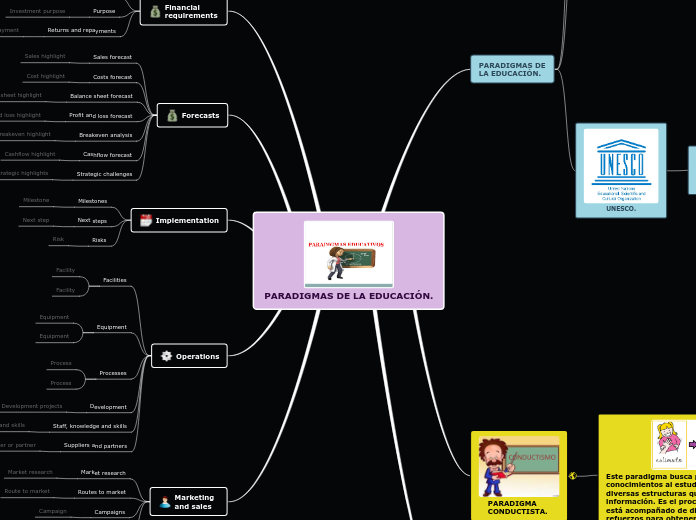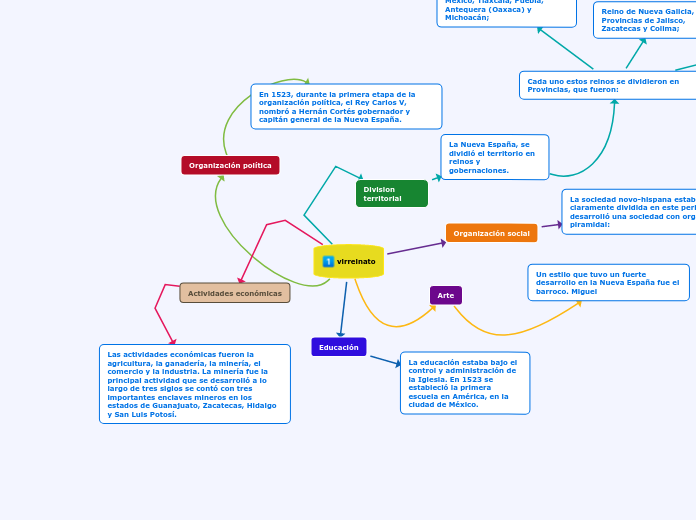PARADIGMAS DE LA EDUCACIÓN.
Type in the name of your organization and press Enter.
Marketing and sales
The question that investors will ask is How will you turn your forecasts into reality?
Having identified your product or service, and the demand for it in the market, how will you reach that market?
What you will sell
Describe exactly what customers will buy, how they will buy it, how it will be provided or delivered, and how it will be supported after purchase.
Think about:
- The selection and decision process
- Ordering and payment
- Delivery of real or virtual goods
- Access to real or virtual services
Campaigns
Campaign
What campaigns are you planning to publicize your product or service? Examples include:
- Press releases
- Special offers
- A promotional series of advertisements
- A launch event or open day
- A competition or prize draw
Routes to market
Route to market
List the ways that you can reach your market segments. Examples include:
- Retail locations, your own or others
- Direct sales representatives
- Online presence
- Email, SMS and telephone calling
- Newsletters and leaflets
- Social media and word of mouth
- Shows and exhibitions
- Press coverage and reviews
- Advertising in newspapers, radio, television or specialist publications
Market research
Add a description of your market research.
What market research have you done to identify the best routes to market for your particular segment?
- Where is the best place for your target segment to find you?
- Where is the best place for you to find your target segment?
Operations
How will the operations of your organization need to change, to support this plan?
Investors will need to know that you will also have the capabilities to deliver it, sustain it and scale it up.
Suppliers and partners
Supplier or partner
- What materials and services will you need from suppliers?
- Who will you need to partner with to make the most of the opportunity?
- Will you depend entirely on them, or do you have alternatives?
Add a supplier or partner.
Staff, knowledge and skills
Staff and skills
- What new staff will be needed?
- What skills and knowledge are needed?
- Will you be able to retrain existing staff?
- Can you recruit the right people?
- Are you expecting the investors to bring expertise and resources?
Add staff, knowledge or skills.
Development
Development projects
- What new things need to be designed and developed to deliver this opportunity?
- Are these new developments or enhancements of existing products and services?
- Will they involve research and prototypes?
Add a development project.
Processes
Process
What new processes will you need to establish? Do you need to change existing processes?
Processes include:
- Leadership and strategy
- Design and development
- Production & delivery
- Marketing and sales
- Financial and administrative
- Customer service and support
Add a process.
Equipment
What new equipment and tools will you need? Will you replace old ones, or extend your capacity?
Add capital equipment.
Facilities
Facility
How will your facilities need to change to implement your plan?
Will you need new premises or changes to existing premises?
Add a facility.
Implementation
If you win the investment or support that you need, where will you start?
Risks
Risk
- How will you manage risk in your plan? What could go wrong?
- How are you planning to reduce the chances of a problem occurring?
- How are you planning to reduce the impact if it does?
Add a risk.
Next steps
Next step
- What are the next steps in your plan?
- If you win support, where will you begin?
- If you don't, what is your backup plan?
Add the next step.
Milestones
Milestone
What are the key points in the implementation of your plan? How will you know that you are making real progress?
Think about:
- Signing key agreements and contracts
- Appointing new staff
- Completing development and design work
- Events and campaigns
- First production
- First sales
- First press coverage and reviews
Add a milestone.
Forecasts
You will need credible forecasts of profitability and strategic benefits if you are proposing investment in your business.
Strategic challenges
Strategic highlights
What is the impact on your strategy of this initiative? How will your strategy change to ensure that you can adapt to whatever this plan brings, whether it is good or not so good? Think about:
- The best and worst case scenarios
- How you will respond to best and worst case scenarios
- Your exit routes if things do not go according to plan
- How your strategic position will change
- What new opportunities could arise as a result of this change
Add a strategic point.
Cashflow forecast
Cashflow highlight
Even if your plan will eventually be profitable, cashflow limitations could prevent you from getting there. Your cash flow forecast should show that you are in control of this.
Consider:
- The best and worst cases for financial exposure
- The effects of late payment from customers
- When payback begins
- When payback completes and profitability begins
Add a key point from the cashflow forecast.
Breakeven analysis
Breakeven highlight
Your breakeven analysis should show the minimum level of achievement that is still survivable. If operations go below breakeven, then you will need to take evasive action. Make forecasts for:
- Survival-level costs and expenses
- What could be delayed or dropped from the plan to reduce costs
- Worst cases for implementation delays and cost overruns
- Minimum sales performance
Profit and loss forecast
Profit and loss highlight
Your profit and loss (or income) forecasts should detail where, when and how profitability will be achieved.
Add a highlight from your Profit and Loss forecast.
Consider making forecasts for year 1, year 2 and year 3 of your plan.
Balance sheet forecast
Balance sheet highlight
How will your balance sheet change as a result of this initiative?
- What new assets will you gain?
- What liabilities will you take on?
- How will the ownership of equity change?
Add a key point from the balance sheet forecast.
Costs forecast
Cost highlight
How will your costs base change as a result of your initiatives? Think about:
- Changes in fixed costs and overheads
- Changes in variable costs with volume
- Changes in variable costs with better equipment, better processes or better product design
- Changes in materials costs with volume
Add a key point from the costs forecast.
Sales forecast
Sales highlight
How will sales increase as a result of your initiatives? Think about:
- Increased sales volume
- Increased average value of sales
- Increased sales to existing customers
- Opening up new markets and segments
Add a key point from the sales forecast.
It must be clear to investors what you are asking for, when you need it and when & how it will be repaid - in short, what value they will get for their investment.
Returns and repayments
Return or repayment
Add highlights of the return or repayment plan for investors. Consider:
- Equity ownership and rising value of equity
- Equity buy-back
- Other benefits, e.g. future stock options
- Repayment of capital
Purpose
Investment purpose
Add a sum-up of how this investment will be spent. Include:
- Purchasing assets
- Paying wages or overheads
- Buying stock and materials
- Investing in training or advisors
- Servicing loans
Schedule
Investment schedule
Add a summary of how much is required and when.
PARADIGMA COGNITIVO.
Investors will ask: how well do you know your customers and your market? Your business plan should show that you are targeting your market by well-defined segments and are focused on creating value for customers.
Se define como un conjunto de principios teóricos y de programas de investigación relativos al funcionamiento de la mente en general y de la adquisición de conocimientos en particular.
Las ideas de este paradigma
fueron aportadas y enriquecidas
por investigadores teóricos,
como: Piaget, psicología genética,
Ausubel , la teoría de la Gestalt,
Bruner y el aprendizaje por
descubrimiento y las aportaciones
de Vygotsky , sobre la socializan
en los procesos cognitivos superiores.
Add an organization that can compete with you, either now or in the future. Think about all alternatives that the customer may have, including doing nothing or addressing their problem in a completely different way.
Strategies
Strategy
How will you compete effectively?
Add an element of your competitive strategy. Think about:
- Outperforming them on their strengths
- Outperforming them on their weaknesses
- Having a better value proposition
- Being different and difficult to compare
- Offering additional benefits
- Offering a better customer experience
Weaknesses
Weakness
What do the competitors do that is less attractive than your product or service?
Do they have:
- Higher pricing?
- Lower performance or unreliability?
- A complex proposition that is difficult to understand?
- A poor reputation for value?
- Poor customer service?
- An inconvenient location?
Strengths
Strength
What do the competitors do that is more attractive than your product or service?
Do they have:
- Better pricing or total cost of ownership?
- A more up-to-date design?
- Better performance and reliability?
- A good brand name and reputation?
- Good customer service?
- Additional benefits?
Product or service
Describe the competing product or service
- Do they compete with you now or will they compete with you in the future?
- What do they provide that competes with you?
- Does it directly compete, or offer an alternative way to solve the problem?
PARADIGMA CONDUCTISTA.
Describe the vision and the opportunity that the plan is based on.
The investor's question you answer here is Where are you headed, and why?
Este paradigma busca proporcionar conocimientos al estudiantes a través de diversas estructuras que refuercen la información. Es el proceso de aprendizaje está acompañado de diversos estímulos y refuerzos para obtener una respuesta positiva de aprendizaje.
Para el paradigma
conductista
el Maestro:
Consiste en desarrollar
una adecuada serie de arreglos de
contingencia de reforzamiento
y control de estímulos para enseñar.
Para el paradigma
conductista
el alumno:
Where do you want to be in 5 years?
Where would you like to be in terms of:
- Company size, turnover and profitability?
- Financial strength and independence?
- Structure and ownership?
- Market leadership and reputation?
- Competitiveness?
- Core skills and capabilities?
- Positioning for an exit strategy?
Se ve al alumno como un sujeto cuyo desempeño y aprendizaje escolar pueden ser arreglados o re-arreglados desde el exterior (la situación, los métodos, los contenidos,etc.
Although the executive summary appears first in the document, it is easier to complete it last, when you can summarise and prioritize the key points in your plan.
UNESCO.
En 1998 la UNESCO estableció
la necesidad de que los gobiernos
diseñaran planes y programas
educativos por competencias, sobre
la base de cuatro pilares básicos.
List the benefits that will come from pursuing this opportunity. Include:
- Profitability
- Payback timescales
- Customer benefits
- Strategic benefits
Aprender a ser.
Aprender a vivir juntos.
Aprender a hacer.
Aprender a
conocer.
Financial requirements
Enseñanza-aprendizaje: incorporación de nuevos modelos organizativos, estructuras e ideas, metodologías distintas , y practicas pedagógicas con el fin de busca una nueva educación.
List the financial aid and other support that you are seeking, so that you can take advantage of this opportunity.
Es un modelo mental que filtra nuestras percepciones, organiza nuestros saberes
en torno a un esquema, los relaciona de
un modo determinado; nos dice en definitiva
cómo pensar, cómo enseñar, cómo aprender,
cómo solucionar un problema.
La palabra “educo” (é= fuera, desde y “duco” = extraigo, guío, conduzco).
Your mission
Summarise the value and the difference that your organization aims to create. Mission statements are more useful if they describe the difference that you want to make to your customer's lives, rather than what you want to achieve personally. Your mission statement should directly influence strategic decisions.









